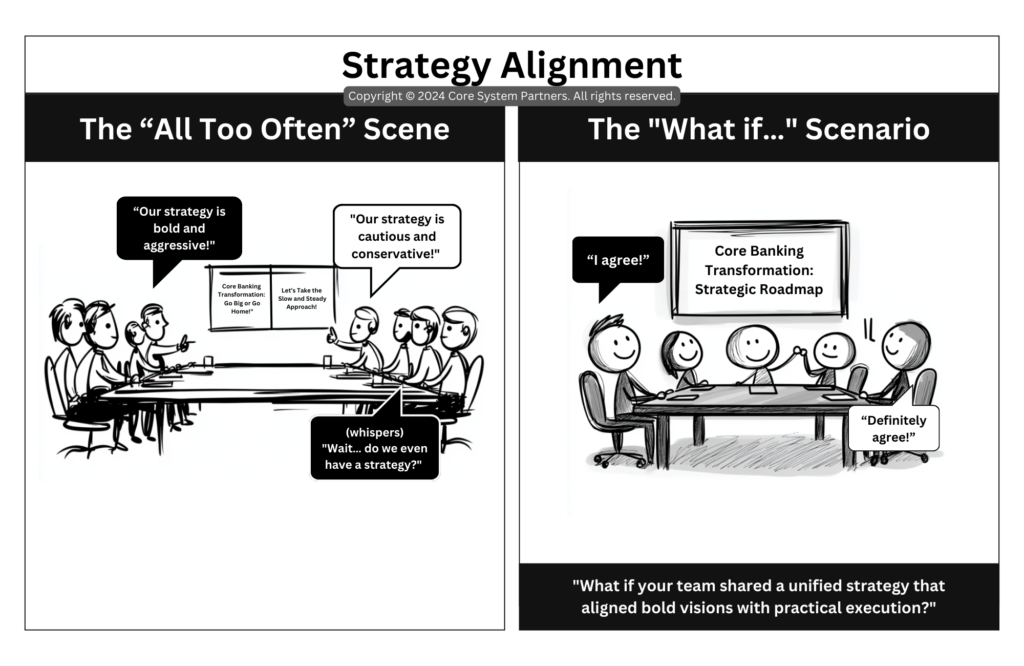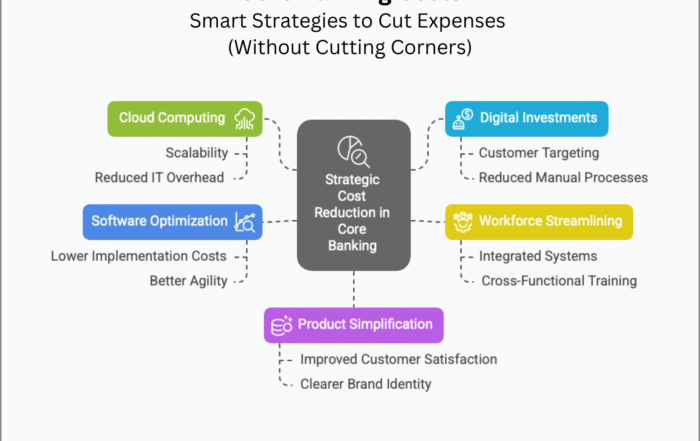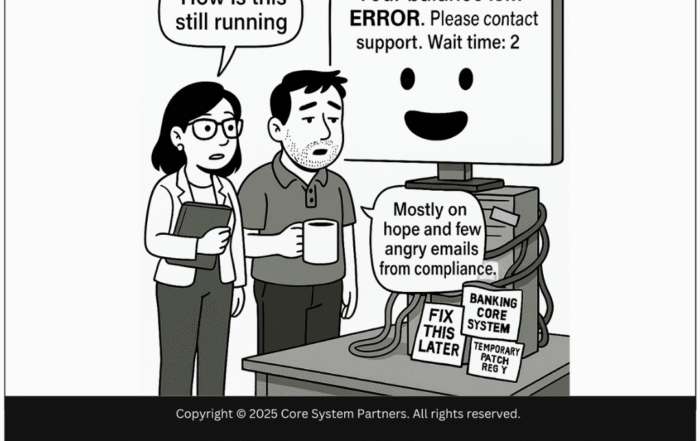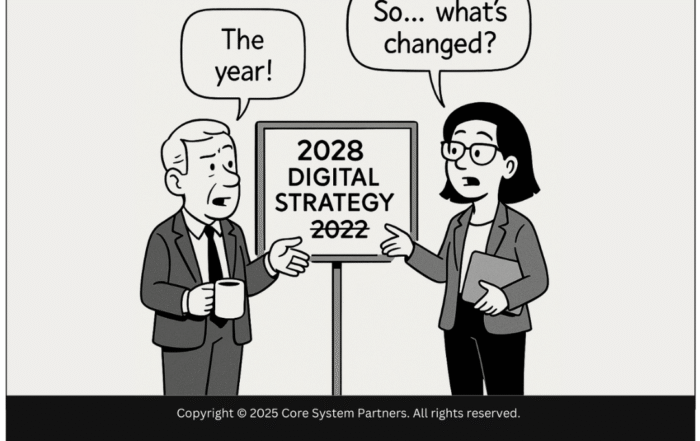
Achieving strategy alignment in core banking transformation turns confusion into coordination, boosting efficiency, collaboration, and successful outcomes.
In the fast-paced world of core banking, few things are as critical as having a clear and unified strategy. Yet, far too often, teams find themselves in meetings resembling “The All Too Often” Scene: a room filled with conflicting voices, each championing a different approach. Some argue for bold and aggressive action—“Go big or go home!”—while others insist on caution, urging a slow and steady pace. Amid the debate, one person sheepishly whispers, “Wait… do we even have a strategy?”
Sound familiar? It’s a scene that highlights the risks of unstructured responsibilities and a lack of strategic alignment. But what if there was another way? In “The What If…” Scenario, we see a vision of harmony: a team gathered around a table, smiling and agreeing on a shared roadmap. Everyone is aligned on a clear, actionable strategy for their core banking transformation. Let’s explore how banks can move from chaos to coordination by fostering a unified approach.
The Cost of Unstructured Responsibilities
Disjointed strategies and unclear roles don’t just slow down progress—they create confusion and erode trust. When responsibilities aren’t clearly defined, or when strategies pull in opposite directions, teams waste time and resources, and frustration builds.
The “All Too Often” Scene: What Goes Wrong?
- Conflicting Priorities: Different teams push for different approaches without considering how they align with the bank’s overall goals.
- Unclear Roles: When no one knows who’s responsible for what, accountability slips through the cracks.
- Stalled Progress: Endless debates over strategy lead to inaction, leaving teams feeling stuck and demoralized.
I’ve been in those meetings where everyone has an opinion, but no one has a clear plan. It’s not just unproductive—it’s exhausting. Without alignment, even the best ideas fail to gain traction.
The Power of a Coordinated Team Approach
In contrast, “The What If…” Scenario shows us what’s possible when teams come together around a unified strategy. Here, stakeholders share a common vision, and every decision is guided by a clear, strategic roadmap. This is the power of alignment: when teams are on the same page, transformation becomes not just possible but inevitable.
What Makes Coordination Work?
- A Unified Vision: When everyone agrees on the big picture, individual efforts naturally align.
- Defined Responsibilities: Clear roles ensure that every team member knows their part in the strategy, reducing overlap and confusion.
- Actionable Plans: A strategic roadmap breaks down high-level goals into achievable steps, making it easier for teams to execute.
This kind of alignment doesn’t just happen—it’s the result of intentional effort and collaboration. But when it does, the results are transformative.
Moving from Chaos to Coordination: Practical Steps
Shifting from the disarray of “The All Too Often” Scene to the cohesion of “The What If…” Scenario requires a commitment to clarity and collaboration. Here’s how you can make it happen:
1. Establish a Unified Strategic Roadmap
Start by defining your core banking transformation goals. Make sure they’re clear, measurable, and aligned with the bank’s mission. Then, break them down into actionable steps.
- Example: Your roadmap might include phases like system modernization, employee training, and customer experience enhancements. Assign timelines and milestones to each phase.
2. Clarify Roles and Responsibilities
Every stakeholder should know exactly what they’re responsible for. This not only prevents duplication of effort but also ensures accountability.
- Example: Assign a Strategy Lead to oversee the roadmap, with individual team leads responsible for specific phases. Clearly outline expectations for each role.
3. Foster Open Communication
Regular updates and check-ins are essential for maintaining alignment. Create forums where teams can share progress, discuss challenges, and adjust strategies as needed.
- Example: Hold weekly alignment meetings where each team provides a quick update on their progress and any roadblocks they’re facing.
4. Use Visual Tools to Drive Clarity
A shared visual representation of your strategy—like the “Core Banking Transformation: Strategic Roadmap” in “The What If…” Scenario—can help teams stay focused and aligned.
- Example: Use project management software or a shared dashboard to track progress and display milestones. This creates transparency and fosters a sense of shared purpose.
5. Celebrate Milestones and Successes
Recognize and celebrate progress along the way. This not only boosts morale but also reinforces the value of working together toward a common goal.
- Example: When a major milestone is achieved, like completing the first phase of the transformation, host a team celebration or send out a company-wide update to acknowledge everyone’s efforts.
The Benefits of a Unified Strategy
When teams are aligned around a clear, actionable strategy, the benefits ripple throughout the organization:
1. Increased Efficiency
Aligned teams waste less time on debates and duplicative efforts, allowing them to focus on execution.
2. Enhanced Collaboration
A shared vision fosters trust and cooperation, breaking down silos and encouraging cross-departmental teamwork.
3. Better Outcomes
With everyone working toward the same goals, projects are more likely to succeed, delivering value for the bank and its customers.
In my experience, the difference between an aligned team and a disjointed one is night and day. Alignment doesn’t just make work easier—it makes success inevitable.
Building Your “What If…” Scenario
In core banking transformation, strategy alignment is the foundation for success. Without it, even the best ideas can falter. But with a unified vision, clear roles, and actionable plans, teams can move from the confusion of “The All Too Often” Scene to the harmony of “The What If…” Scenario.
So, ask yourself: Is your team aligned around a shared strategy, or are you still navigating conflicting visions? By investing in alignment, you can create a roadmap that not only drives transformation but also empowers every team member to contribute their best. Let’s start building that future—together.
#CoreBankingTransformation #CoreBankingReadiness





